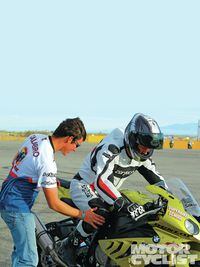I’ve been asked this question a hundred times: “What could you possibly be teaching a rider like (insert name of roadracing rock star), who is already a podium guy at world-championship level?” I’ve never had what I’d call an intelligent answer, but people always expect something really wise—some insight into a new or miraculous aspect of riding they’d never heard of before. Of course, there never is. It’s always something very simple, basic and mundane, yet very important to the rider who is struggling with it. See if any of these sound familiar to you...
How can I be more confident, go faster, find good lines, brake harder, lean over farther, trust my tires, not panic, quit running wide, handle S-curves, not stiffen up, feel more relaxed, have better entry speed, stop target-fixating, keep my balance at slow speeds, downshift smoothly, get my knee down, stop the bike wiggling, make fewer steering corrections, handle a slide, get better drives, make smooth starts, make the bike feel planted, have good body position, handle emergencies, brake in turns, avoid obstacles and improve my lap times?
That adds up to 27 items that are now, or have been, on every rider’s list for improvement. Which ones are still on yours?
There are answers for each of them—not just tricks you can do in a parking lot that will make you feel good, but actual techniques and drills that allow riders to tick that challenge off their list.
I’ll give you an example: Over a five-year period, I’ve run a thousand street riders through a very controlled program that, in addition to improving other riding skills, has improved their average stopping distance from 60 mph by 60 feet. How long does that training take? About an hour. It consists of assessing and measuring the rider’s baseline braking, then coaching him through the feel and fear of using the brakes. Finally, it’s about applying what he learned at speed and re-measuring his stopping distance.
Who was tested and trained in my research and development of this program? Riders on everything from choppers to dual-sports to sportbikes to tourers. They ranged from individuals who had barely ridden a bike to those who’d logged 100,000 miles. They were mostly men, but a few women participated. The range of error for the distance testing was plus or minus 6 feet. Range of error for measured speed was plus or minus 2 mph.
Would training that reduced your stopping distance by 25 to 50 percent be valuable to you? How would it make you feel if you could stop your motorcycle in roughly the same distance as the professional rider who tested your model bike for the magazine? How many lives would be saved if everyone had truly effective rider training? What’s the point of me telling you this?
The technology exists to coach an average rider through a series of well-designed programs that don’t just bring him up to the skill level of passing a cone-weave course in the DMV test area at 12 mph, but that could, in the very real world of riding, literally save his life. The braking drill described above offers a solution for one of the 27 items on our list. And yes, there are solutions for all the others.
For my part, I can’t decide if I derive more satisfaction from coaching a rider onto the podium in world competition, or from transforming someone who was completely inept and probably should never have ridden a motorcycle.
That’s a question I’ve asked myself a hundred times.











/cloudfront-us-east-1.images.arcpublishing.com/octane/QCZEPHQAMRHZPLHTDJBIJVWL3M.jpg)
/cloudfront-us-east-1.images.arcpublishing.com/octane/HXOUJXQWA5HBHGRO3EMJIGFMVI.jpg)

/cloudfront-us-east-1.images.arcpublishing.com/octane/3TIWWRV4JBBOLDVGRYECVVTA7Y.jpg)
/cloudfront-us-east-1.images.arcpublishing.com/octane/KIX5O23D5NAIBGFXBN3327DKZU.jpg)
/cloudfront-us-east-1.images.arcpublishing.com/octane/7GJYDUIPXRGMTMQKN6ONYOLBOU.jpg)
/cloudfront-us-east-1.images.arcpublishing.com/octane/MUQLOVLL2ZDGFH25ILABNBXKTI.jpg)
/cloudfront-us-east-1.images.arcpublishing.com/octane/TNOU5DNE2BC57MFPMGN2EIDXAM.jpg)
/cloudfront-us-east-1.images.arcpublishing.com/octane/GTCXACQGJ5HAPDTGWUQKDEH44E.jpg)
/cloudfront-us-east-1.images.arcpublishing.com/octane/S35YGSEMEZB4BLTDJTSZPF4GLA.jpg)
/cloudfront-us-east-1.images.arcpublishing.com/octane/5UOT6HPX2JFMRJAX6EH45AR4MQ.jpg)
/cloudfront-us-east-1.images.arcpublishing.com/octane/OKWOJWAKP5EP3OACCRRWPCIX2Q.jpg)
/cloudfront-us-east-1.images.arcpublishing.com/octane/2WF3SCE3NFBQXLDNJM7KMXA45E.jpg)
/cloudfront-us-east-1.images.arcpublishing.com/octane/G4MG6OUCJNBSHIS2MVVOTPX65E.jpg)
/cloudfront-us-east-1.images.arcpublishing.com/octane/IIGGWFOTOJGB7DB6DGBXCCMTDY.jpg)
/cloudfront-us-east-1.images.arcpublishing.com/octane/QSTCM6AVEZA5JJBUXNIQ3DSOF4.jpg)
/cloudfront-us-east-1.images.arcpublishing.com/octane/U4I7G625B5DMLF2DVIJDFZVV6M.jpg)
/cloudfront-us-east-1.images.arcpublishing.com/octane/B6XD6LS6IVCQPIU6HXDJSM3FHY.jpg)
/cloudfront-us-east-1.images.arcpublishing.com/octane/ICL63FEDDRDTTMINYICCEYGMDA.jpg)
/cloudfront-us-east-1.images.arcpublishing.com/octane/FCGZHQXRBZFLBAPC5SDIQLVF4I.jpg)
/cloudfront-us-east-1.images.arcpublishing.com/octane/WNOB6LDOIFFHJKPSVIWDYUGOPM.jpg)

/cloudfront-us-east-1.images.arcpublishing.com/octane/X33NU3E525ECRHXLNUJN2FTRKI.jpg)
/cloudfront-us-east-1.images.arcpublishing.com/octane/6KKT5NNL2JAVBOXMZYS5ZO76YA.jpg)